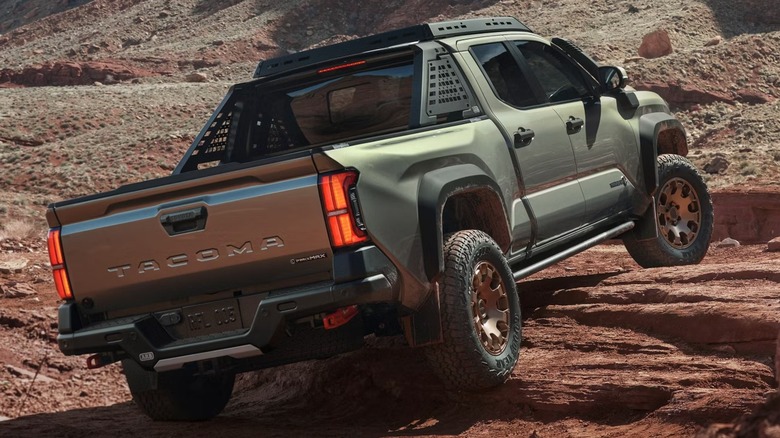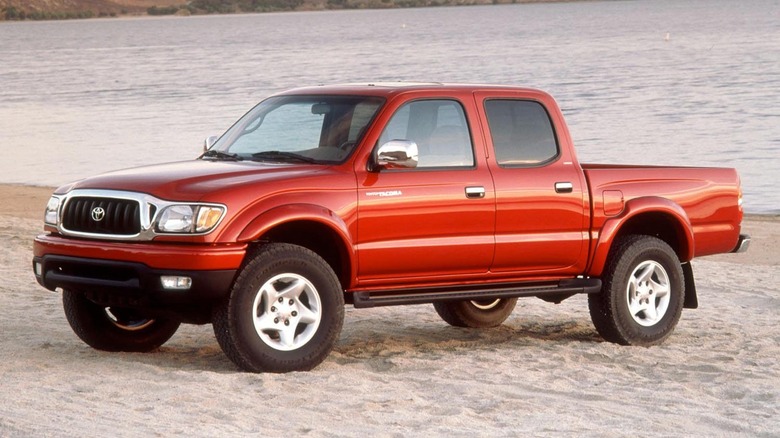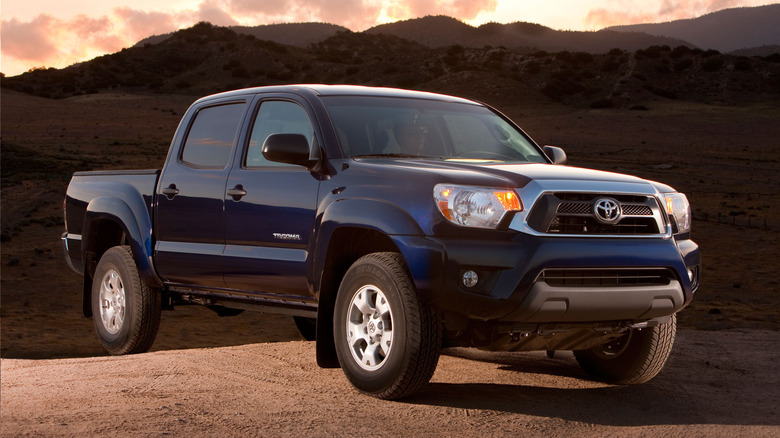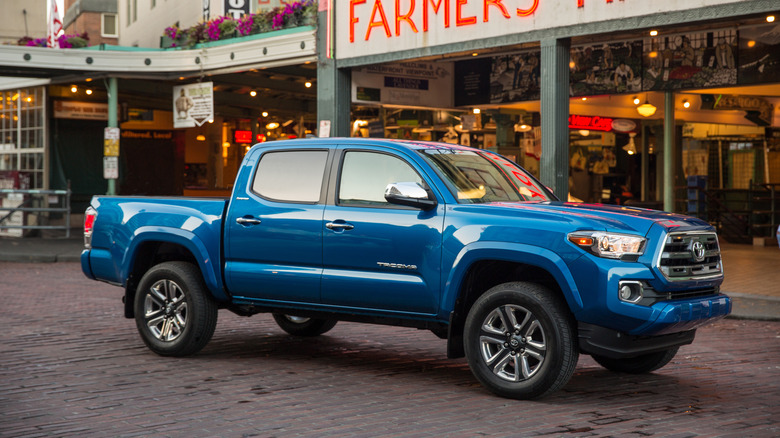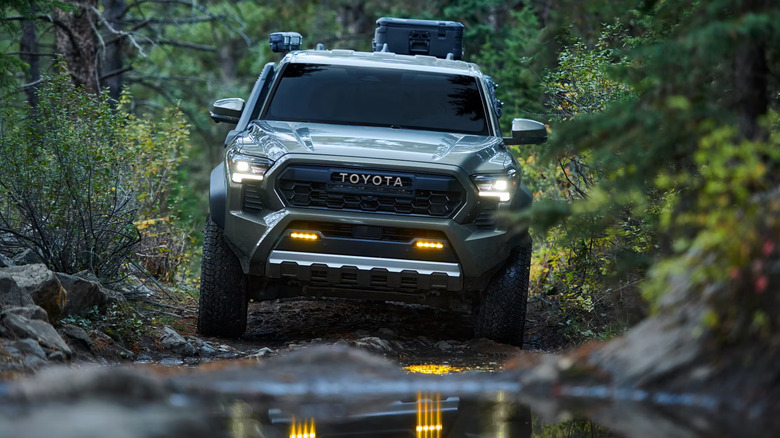Everything To Know Before Buying A Toyota Tacoma
For anyone who's been under a rock for the past three decades or doesn't give a lot of thought to trucks, the Toyota Tacoma is a best-selling, midsize truck that was introduced in 1995. It began as a basic, compact work truck that has transformed and expanded over four generations into a truck-of-many-trims that handle off-roading, in-town driving, and towing.
In its early years, the Tacoma handily took on competitors like the Chevy S-10 and Ford Ranger with its functional interior and off-road cred earned from its four-wheel drive and all-terrain-ready approach and departure angles underneath. But, as the competition heated up, Ford and Chevy frequently bested the Tacoma because it had a harsher ride and its interior appointments were only infrequently updated.
In 2024, Toyota unveiled a re-designed Tacoma for its fourth generation, with improvements all around to take on midsize trucks from Chevy, Nissan, RAM, and Ford. If you're looking to buy a Tacoma — new or used — here is what you need to know about each generation before shopping.
1995-2004: First-gen's rust and safety testing issues
Tacoma shoppers should consider which engine they want, as it varies by generation. Originally, engines were available in an inline 2.4L or 2.7L four-cylinder with 160 and 177 lb.-ft of torque, or a 3.4L V6 with 220 lb-ft. Horsepower for this small truck ranged from 142 to 190 hp. The truck started in 1995 as a rear or four-wheel drive compact truck in regular or XtraCab styles, with a 6-foot bed. A four-door double cab was added in 2001, and by 2004, choices expanded to 17 variations combining base models, PreRunners, and S-Runners, three cab styles, and two bed lengths of 6-feet and 5-feet.
Despite their good reputation for being mechanically reliable, some first-gens didn't have great safety ratings in National Highway Traffic Safety Administration (NHTSA) crash testing. The NHTSA doesn't have ratings for the 1995 model year, but 1996-1997 Tacomas received two out of five stars for driver safety in front crashes, and three stars for passengers. The '97 Extended Cab received one star for the driver. By 1998, the Tacoma safety in front crashes improved, with the Extended Cab receiving four stars for the driver in a front crash; however, it was another three years before side crash safety climbed above one-star.
One more problem area: insufficient rust protection, leading to rust eating away at the leaf springs and the frames for this generation. The issue was so bad, that Toyota responded by offering a 15-year rust and corrosion warranty on certain model years. However, that means if you are looking at a used first-gen to buy, that means the warranty has expired.
2005-2015: Second-gen is bigger and introduces the 4.0L V6
The second-gen, starting in 2005, was introduced with a 2.7L inline four that produced 164 horsepower. Since this gen grew in wheelbase and track to be midsized, Toyota also offered a bigger 4.0L V6 rated at 245 horsepower and 282 lb-ft. It's the same engine found in Tundras and 4Runners. The regular cab style was phased out; double cab continued, and the Access Cab — with two rows of seating and suicide doors to enter and exit the rear seats — was introduced.
Toyota made considerable safety improvements in its 2005 Tacoma redesign. This model year received five stars in front and side crash tests. It was still one of the model years with rust issues, but in 2016, Toyota settled a suit related to frame rust, agreeing to inspect and if necessary replace frames for Tacoma model years 2005 to 2010. The 2011 model year hit a sophomore slump in safety testing: even with rust issues behind it, it declined to three out of five stars in NHTSA frontal crash tests, with passenger-side results falling to two stars.
Model years 2012 to 2015 saw Toyota really pushing to win over off-roading enthusiasts with its T|X and T|X Pro Off-Road packages, and a TRD Off-Road Package that rode on Bilstein-brand shocks, progressive-rate front springs, and rugged trail tires.
2016 -2023: Third-gen has high resale value
By the time Toyota introduced its third-gen Tacoma in 2016, competitors like the Chevy Colorado were offering turbodiesels under the hood. However, the Tacoma never went diesel for the U.S. market. Instead, Toyota offered a 2.7L inline four rated at 159 hp, or a 3.5L V6 with 278 hp and 180 lb-ft of torque. This generation came in two body styles –- an extended and a crew cab -– with a 5- or 6-foot bed. It was available in six trims, including the new Trail Special Edition and TRD Pro.
Everyone knows new cars lose value as soon as they leave the sales lot. This applies to the Tacoma, too, but this truck hangs on to resale value better than most. A new Tacoma sold five years later could bring in nearly 70% of its original selling price. Buyers should be prepared to pay more for the Tacoma's reliability and durability, whether they are shopping for new or used. However, owners will likely get more from selling a Tacoma than they would selling a similarly outfitted Nissan or Chevy.
2024: Fourth-gen has new powertrains and more off-road trims
This generation got new engines — a turbocharged four-cylinder and a hybrid, called the i-Force and I-Force Max, respectively. The base i-Force on the SR trim is a 2.4L gas engine producing 228 hp. On other trims, the 2.4L delivers 278 hp and 278 lb-ft. of torque paired with an eight-speed automatic; with a six-speed manual transmission, horsepower sinks to 270 but torque climbs to 310 lb-ft. The i-Force Max combines a 2.4L engine with an electric motor and battery pack. It's standard on the Trailhunter and TRD Pros and available on other trims, kicking out 326 hp with 465 lb-ft. of torque for better towing.
This gen features eight trims: the SR, SR5, TRD PreRunner, TRD Sport, TRD Off-Road, Limited, Trailhunter, and TRD Pro — three of which use a hybrid powertrain or ICE. The redesigned Tacoma is available as an XtraCab, or double cab, with five- or six-foot beds. Upholding Toyota's off-road reputation, four of these trims were built for rugged terrain: the TRD PreRunner, TRD Off-Road, TRD PRO, and the newest -– the Trailhunter, a hybrid four-door loaded with top-tier creature comforts.
It sports a high-clearance front bumper, rock rails, and a steel rear bumper with recovery hooks to stay out of trouble. Like the other fourth-gen off-roaders, it offers Downhill Assist Control and Crawl Control, which handle speed autonomously over hairy terrain, so drivers can focus on steering. Not to mention, several new other features worth being excited about.
